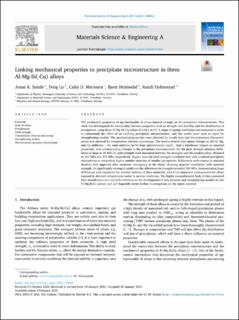| dc.contributor.author | Sunde, Jonas Kristoffer | |
| dc.contributor.author | Lu, Feng | |
| dc.contributor.author | Marioara, Calin Daniel | |
| dc.contributor.author | Holmedal, Bjørn | |
| dc.contributor.author | Holmestad, Randi | |
| dc.date.accessioned | 2021-05-19T08:58:33Z | |
| dc.date.available | 2021-05-19T08:58:33Z | |
| dc.date.created | 2021-01-29T09:19:40Z | |
| dc.date.issued | 2021 | |
| dc.identifier.citation | Materials Science & Engineering: A. 2021, 807, . | en_US |
| dc.identifier.issn | 0921-5093 | |
| dc.identifier.uri | https://hdl.handle.net/11250/2755603 | |
| dc.description.abstract | The mechanical properties of age hardenable Al alloys depend strongly on the precipitate microstructure. This work has investigated the relationship between properties such as strength and ductility and the distribution of precipitates, using three Al-Mg-Si(-Cu) alloys (Cu≤0.1 at.%). A range of ageing conditions was examined in order to understand the effect of an evolving precipitate microstructure, and the results were used as input for strengthening models. The mechanical properties were obtained by tensile tests and microstructure characterisation was attained by transmission electron microscopy. The results showed that minor changes to the Si, Mg, and Cu additions – the total addition (at.%) kept approximately equal – had a significant impact on material properties, with corresponding changes in the precipitate microstructure. On the peak strength plateaus differences as large as 35 MPa in yield strength were measured between the strongest and the weakest alloy, obtained as 410 MPa and 375 MPa, respectively. Higher material yield strength correlated well with a refined precipitate microstructure comprising higher number densities of smaller precipitates. Differences with respect to material ductility first appeared after moderate overageing of the alloys, showing negative correlation with material strength. At significantly overaged conditions the differences in strength exceeded 100 MPa, demonstrating large differences with respect to the thermal stability of these materials, which has important consequences for alloys exposed to elevated temperatures under in-service conditions. The highly comprehensive body of data presented here should serve as a valuable reference in the development of precipitation and strengthening models for the Al-Mg-Si-Cu system and will hopefully incite further investigations on the topics covered. | en_US |
| dc.language.iso | eng | en_US |
| dc.publisher | Elsevier Science | en_US |
| dc.rights | Navngivelse 4.0 Internasjonal | * |
| dc.rights.uri | http://creativecommons.org/licenses/by/4.0/deed.no | * |
| dc.title | Linking mechanical properties to precipitate microstructure in three Al-Mg-Si(-Cu) alloys | en_US |
| dc.type | Peer reviewed | en_US |
| dc.type | Journal article | en_US |
| dc.description.version | publishedVersion | en_US |
| dc.source.pagenumber | 10 | en_US |
| dc.source.volume | 807 | en_US |
| dc.source.journal | Materials Science & Engineering: A | en_US |
| dc.identifier.doi | 10.1016/j.msea.2021.140862 | |
| dc.identifier.cristin | 1881932 | |
| dc.relation.project | Norges forskningsråd: 247783 | en_US |
| dc.relation.project | Norges forskningsråd: 197405 | en_US |
| dc.description.localcode | This is an open access article distributed under the terms of the Creative Commons CC-BY license, which permits unrestricted use, distribution, and reproduction in any medium, provided the original work is properly cited. | en_US |
| dc.source.articlenumber | 140862 | en_US |
| cristin.ispublished | true | |
| cristin.fulltext | original | |
| cristin.qualitycode | 2 | |

